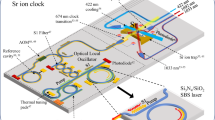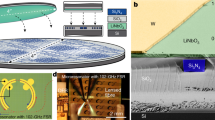Abstract
Compact narrow-linewidth visible lasers are pivotal components for optical sensing, metrology and communications, as well as precision atomic and molecular spectroscopy. With an emission bandwidth approaching an octave, titanium-doped sapphire (Ti:Sa) lasers are key tools for producing solid-state lasing across visible and near-infrared bands; however, today’s commercial Ti:Sa laser systems require high pump power and rely on expensive tabletop components, which restrict them to laboratory settings. In this paper we present a photonic-circuit-integrated Ti:Sa laser that combines the Ti:Sa gain medium with a silicon-nitride-on-sapphire integrated photonics platform, resulting in high portability with minimal power consumption. We demonstrate Ti:Sa lasing from 730 nm to 830 nm by tightly confining the pump and lasing modes to a single microring resonator, reducing the lasing threshold by orders of magnitude down to 6.5 mW when compared with the free-space Ti:Sa lasers. Due to the low threshold, turn-key Ti:Sa laser operation is achieved by leveraging a commercially available indium gallium nitride pump diode. Our prototype photonic-circuit-integrated Ti:Sa laser opens a reliable pathway for broadband tunable lasers in the next generation of active–passive-integrated visible photonics.
This is a preview of subscription content, access via your institution
Access options
Access Nature and 54 other Nature Portfolio journals
Get Nature+, our best-value online-access subscription
$29.99 / 30 days
cancel any time
Subscribe to this journal
Receive 12 print issues and online access
$209.00 per year
only $17.42 per issue
Buy this article
- Purchase on Springer Link
- Instant access to full article PDF
Prices may be subject to local taxes which are calculated during checkout





Similar content being viewed by others
Data availability
The data that support the findings of this study are available at https://doi.org/10.5281/zenodo.7425191.
Code availability
All relevant computer codes supporting this study are available from the corresponding author on reasonable request.
References
Moulton, P. Ti-doped sapphire: tunable solid-state laser. Optics News 8, 9 (1982).
Moulton, P. F. Spectroscopic and laser characteristics of Ti:Al2O3. J. Opt. Soc. Am. B 3, 125–133 (1986).
Fomichev, S., Popruzhenko, S., Zaretsky, D. & Becker, W. Laser-induced nonlinear excitation of collective electron motion in a cluster. J. Phys. B 36, 3817 (2003).
Ishii, N. et al. Carrier-envelope phase-dependent high harmonic generation in the water window using few-cycle infrared pulses. Nat. Commun. 5, 1–6 (2014).
Stobińska, M. et al. Quantum interference enables constant-time quantum information processing. Sci. Adv. 5, eaau9674 (2019).
Popmintchev, D. et al. Ultraviolet surprise: efficient soft X-ray high-harmonic generation in multiply ionized plasmas. Science 350, 1225–1231 (2015).
Sótér, A. et al. High-resolution laser resonances of antiprotonic helium in superfluid 4He. Nature 603, 411–415 (2022).
Ideguchi, T. et al. Coherent raman spectro-imaging with laser frequency combs. Nature 502, 355–358 (2013).
Grinin, A. et al. Two-photon frequency comb spectroscopy of atomic hydrogen. Science 370, 1061–1066 (2020).
Kumagai, H. et al. Ablation of polymer films by a femtosecond high-peak-power Ti:sapphire laser at 798 nm. Appl. Phys. Lett. 65, 1850–1852 (1994).
Curley, P., Ferguson, A., White, J. & Amos, W. Application of a femtosecond self-sustaining mode-locked Ti:sapphire laser to the field of laser scanning confocal microscopy. Opt Quantum Electron. 24, 851–859 (1992).
König, K. Multiphoton microscopy in life sciences. J. Microsc. 200, 83–104 (2000).
Klein, J. & Kafka, J. D. The flexible research tool. Nat. Photon. 4, 289–289 (2010).
Rapoport, W. & Khattak, C. P. Titanium sapphire laser characteristics. Appl. Opt. 27, 2677–2684 (1988).
Spence, D. E., Kean, P. N. & Sibbett, W. 60-fsec Pulse generation from a self-mode-locked Ti:sapphire laser. Opt. Lett. 16, 42–44 (1991).
Fortier, T. M., Bartels, A. & Diddams, S. A. Octave-spanning Ti:sapphire laser with a repetition rate >1 GHz for optical frequency measurements and comparisons. Opt. Lett. 31, 1011–1013 (2006).
Bartels, A., Dekorsy, T. & Kurz, H. Femtosecond Ti:sapphire ring laser with a 2-GHz repetition rate and its application in time-resolved spectroscopy. Opt. Lett. 24, 996–998 (1999).
Hall, J. L. Nobel lecture: defining and measuring optical frequencies. Rev. Mod. Phys. 78, 1279 (2006).
Wall, K. F. & Sanchez, A. Titanium sapphire lasers. Linc. Lab. j. 3, 447–462 (1990).
Hickey, L. M., Apostolopoulos, V., Eason, R. W., Wilkinson, J. S. & Anderson, A. A. Diffused Ti:sapphire channel-waveguide lasers. J. Opt. Soc. Am. B 21, 1452–1462 (2004).
Pollnau, M. et al. Ti:sapphire waveguide lasers. Laser Phys. Lett. 4, 560 (2007).
Grivas, C. et al. Generation of multi-gigahertz trains of phase-coherent femtosecond laser pulses in Ti:sapphire waveguides. Laser Photon. Rev. 12, 1800167 (2018).
Grivas, C., Corbari, C., Brambilla, G. & Lagoudakis, P. G. Tunable, continuous-wave Ti:sapphire channel waveguide lasers written by femtosecond and picosecond laser pulses. Opt. Lett. 37, 4630–4632 (2012).
Wu, L. et al. Growth and laser properties of Ti:sapphire single crystal fibres. Electron. Lett. 31, 1151–1152 (1995).
Yang, T.-T. et al. Widely tunable, 25-mW power, Ti:sapphire crystal-fiber laser. IEEE Photon. Technol. Lett. 31, 1921–1924 (2019).
Azeem, F. et al. Ultra-low threshold titanium-doped sapphire whispering-gallery laser. Adv. Opt. Mater. 10, 2102137 (2022).
Xiang, C. et al. High-performance lasers for fully integrated silicon nitride photonics. Nat. Commun. 12, 1–8 (2021).
Li, N. et al. Monolithically integrated erbium-doped tunable laser on a CMOS-compatible silicon photonics platform. Opt. Express 26, 16200–16211 (2018).
Liu, Y. et al. A photonic integrated circuit-based erbium-doped amplifier. Science 376, 1309–1313 (2022).
Harrison, J., Finch, A., Rines, D. M., Rines, G. A. & Moulton, P. F. Low-threshold, CW, all-solid-state Ti:Al2O3 laser. Opt. Lett. 16, 581–583 (1991).
Wang, S.-C. et al. Laser-diode pumped glass-clad Ti:sapphire crystal fiber laser. Opt. Lett. 41, 3217–3220 (2016).
Guo, X., Zou, C.-L. & Tang, H. X. Second-harmonic generation in aluminum nitride microrings with 2500%/W conversion efficiency. Optica 3, 1126–1131 (2016).
Sorace-Agaskar, C. et al. Versatile silicon nitride and alumina integrated photonic platforms for the ultraviolet to short-wave infrared. IEEE J. Sel. Top. Quantum Electron. 25, 1–15 (2019).
Harder, C., Vahala, K. & Yariv, A. Measurement of the linewidth enhancement factor α of semiconductor lasers. Appl. Phys. Lett. 42, 328–330 (1983).
Stéphan, G., Tam, T., Blin, S., Besnard, P. & Têtu, M. Laser line shape and spectral density of frequency noise. Phys. Rev. A 71, 043809 (2005).
Hulme, J., Doylend, J. & Bowers, J. Widely tunable Vernier ring laser on hybrid silicon. Opt. Express 21, 19718–19722 (2013).
Gorodetsky, M. L., Pryamikov, A. D. & Ilchenko, V. S. Rayleigh scattering in high-Q microspheres. J. Opt. Soc. Am. B 17, 1051–1057 (2000).
Belt, M. & Blumenthal, D. J. Erbium-doped waveguide DBR and DFB laser arrays integrated within an ultra-low-loss Si3N4 platform. Opt. Express 22, 10655–10660 (2014).
Shen, B. et al. Integrated turnkey soliton microcombs. Nature 582, 365–369 (2020).
Xiang, C. et al. Laser soliton microcombs heterogeneously integrated on silicon. Science 373, 99–103 (2021).
Shtyrkova, K. et al. Integrated CMOS-compatible Q-switched mode-locked lasers at 1900 nm with an on-chip artificial saturable absorber. Opt. Express 27, 3542–3556 (2019).
Desiatov, B., Shams-Ansari, A., Zhang, M., Wang, C. & Lončar, M. Ultra-low-loss integrated visible photonics using thin-film lithium niobate. Optica 6, 380–384 (2019).
Liu, X. et al. Ultra-high-Q UV microring resonators based on a single-crystalline AlN platform. Optica 5, 1279–1282 (2018).
Jung, H. et al. Tantala kerr nonlinear integrated photonics. Optica 8, 811–817 (2021).
Sawada, R., Tanaka, H., Sugiyama, N. & Kannari, F. Wavelength-multiplexed pumping with 478-and 520-nm indium gallium nitride laser diodes for Ti:sapphire laser. Appl. Opt. 56, 1654–1661 (2017).
Roth, P. W., Maclean, A. J., Burns, D. & Kemp, A. J. Directly diode-laser-pumped Ti:sapphire laser. Opt. Lett. 34, 3334–3336 (2009).
Acknowledgements
This work is supported by DARPA LUMOS under contract no. HR0011-20-2-0045. We thank X. Liu, A. Bruch, Z. Gong, J. Surya, J. Lu, F. Yang, C. Mi, J. Han and G. Keeler for fruitful discussions. We thank Y. Sun, S. Reinhart, K. Woods and M. Rooks for assistance with device fabrication. We thank J.-h. Kang, R. Elafandy and R. Cheng for their help in material characterization.
Author information
Authors and Affiliations
Contributions
H.X.T. and Y.W. conceived the experiment. Y.W. fabricated the device. Y.W. and J.A.H.-L., performed the experiment. Y.W. and J.A.H.-L. analysed the data. M.V. and Y.G. helped with the project. Y.W. and J.A.H.-L. wrote the manuscript, and all authors contributed to the manuscript. H.X.T. supervised the work.
Corresponding author
Ethics declarations
Competing interests
The authors declare no competing interests.
Peer review
Peer review information
Nature Photonics thanks Arnan Mitchell, Huiyun Liu and the other, anonymous, reviewer(s) for their contribution to the peer review of this work.
Additional information
Publisher’s note Springer Nature remains neutral with regard to jurisdictional claims in published maps and institutional affiliations.
Extended data
Extended Data Fig. 1 Device fabrication.
a. Process flow of the optimized photonic circuit integrated Ti:Sa laser process, including LPCVD SiN deposition, waveguide etch, Ti:Sa crystal bonding and SiON cladding deposition. b. Optical image of a fabricated device depicting the photonic waveguides.
Extended Data Fig. 2 Lasing linewidth measurement.
a. Schematics of the optical set-up for photonic circuit integrated Ti:Sa laser. Heterodyne beatnote measurement using commercial Ti:Sa laser (M2laser) allows measurement of laser linewidth using a fast photodetector (PD) and electrical signal analyser (ESA). b. Heterodyne beating signal between the on-chip Ti:Sa laser and the reference laser with a full-wave half maximum of 120 kHz.
Supplementary information
Rights and permissions
Springer Nature or its licensor (e.g. a society or other partner) holds exclusive rights to this article under a publishing agreement with the author(s) or other rightsholder(s); author self-archiving of the accepted manuscript version of this article is solely governed by the terms of such publishing agreement and applicable law.
About this article
Cite this article
Wang, Y., Holguín-Lerma, J.A., Vezzoli, M. et al. Photonic-circuit-integrated titanium:sapphire laser. Nat. Photon. 17, 338–345 (2023). https://doi.org/10.1038/s41566-022-01144-2
Received:
Accepted:
Published:
Issue Date:
DOI: https://doi.org/10.1038/s41566-022-01144-2
This article is cited by
-
Optically pumped Milliwatt Whispering-Gallery microcavity laser
Light: Science & Applications (2023)
-
Integrated titanium:sapphire laser
Nature Photonics (2023)



